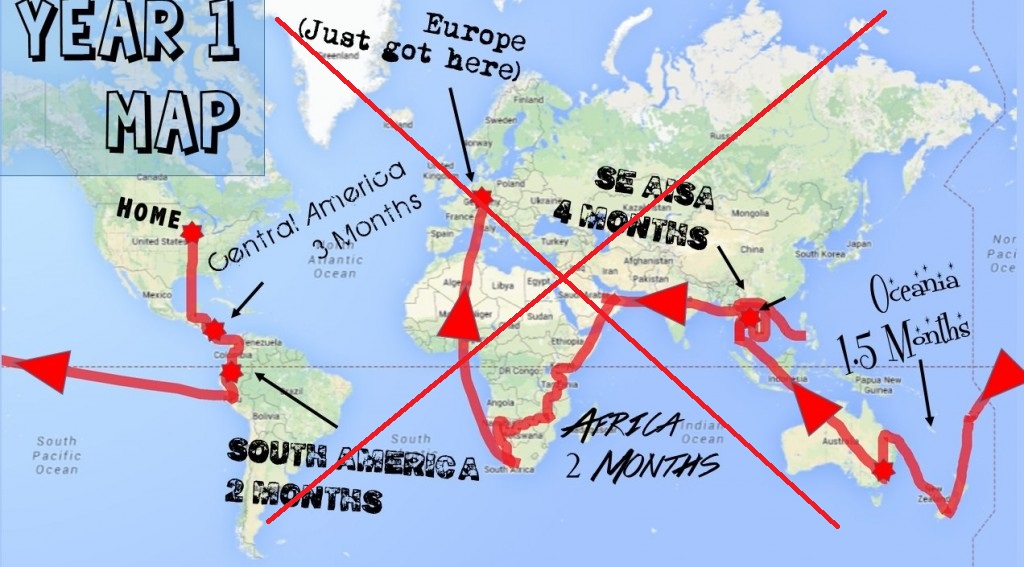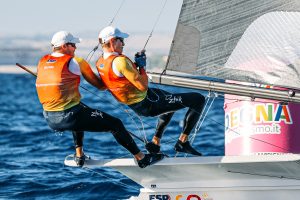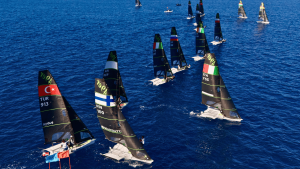World Sailing announced another shift in the Sailing World Cup schedule of events for 2017 through 2020. The schedule delivers on a number of promises made while showcasing that World Sailing has not fully dropped their ISAF ways.
The positives
The 49er (and Nacra) class is thrilled to see that World Sailing will no longer expect all the worlds teams to travel to both major ‘winter’ destinations every season as had previously been expected. At the 2015 World Sailing conference, 49er presented a cost saving measure to alternate between Miami and Melbourne each winter. Such a move would decrease travel, logistics, and shipping costs of Olympic Sailors.
Our 49er proposal received little support from either Miami or Melbourne, both clinging to the belief that the status quo could win out. The recent World Sailing announcement has Miami winning, leaving Melbourne to host their final World Cup as the World Cup Final in December. It rightly rewards Miami and US Sailing’s efforts over the past two Olympic cycles to make Miami a go-to destination for the bulk of the World’s Sailors.
Another positive is the more limited schedule. There will now be 4 World Cup Regattas per year and is the same outcome as dropping Melbourne but from a different point of view. By not replacing Melbourne but rather removing it, the 4 year calendar opens up a bunch of space to fit in Worlds, European, and Olympic qualifying regattas.
The third major positive move comes in 2020, where there will be the Tokyo World Cup Final immediately proceeding the Olympic games. This is a win from so many vantage points as all teams will already be in Tokyo and want a high stakes regatta. It also sets up the sailing audience to get interested in the Olympic regatta. Better still, the new Calendar only has one event in Europe in 2020, learning from the 2016 cycle to create space and focus for the Olympics!
The Negatives
Outside the core proposal of the updated Sailing World Cup, the biggest potential upset to good planning came from a throw away offer that illustrates exactly why the Olympic sailing community is so tired of the last eight years of World Cup developments. Once again, as was completely predictable, turn out for Melbourne is proving a challenge. None of the fleets is entirely made up of elite competitors. Some of the fleets are downright lonely. Australians fill 40% of the participants, with about another 30% of the spots vacant.
To address the situation World Sailing decided that all participants would get an automatic entry into both Sailing World Cup Miami and Hyeres, provided the teams did both. This was meant to be a gesture to reward foreign teams already attending and encourage more foreign teams to add the regatta to their plans, but due to the tight quotas of the 2017 World Cup it opens up the door for undermining Sailing World Cup efforts in both 2017 and 2018.
The Sailing World Cup is meant to be an elite regatta circuit, and to emphasize this point quotas of 40 boats were introduced in 2016 and in the doublehanded classes this has been reduced to 30 boats for 2017. If the 20 49ers already confirmed for Melboune 2016 get organized, and they all ship to Miami and they would all want to go to Hyeres anyways, then that leaves only 10 berths remaining. All the returning Olympians and all of the next generation who want to get into the top levels could be left out… Moving on to 2018, the World Ranking is so heavily influenced by Sailing World Cup regattas that these same teams that make the 2017 World Cup would likely also make the 2018 World Cup, thereby undermining the circuit just as World Sailing is trying to build it up again.
Awarding automatic bids to future World Cups to attend an event that most want to skip is classic ISAF. Bully the sailors to attend instead of providing them with compelling events. It’s exactly what this iteration of the World Cup was supposed to avoid… but even with a name change, if the players are the same the outcomes will be the same.
This moves us to the second negative point about the World Cup which is the quotas themselves. It is well documented how difficult it is to run a regatta with over 1000 boats spread across 10 fleets, which is one of the reasons World Sailing started restricting the World Cup. However, like many of the other unnecessary principle set up by the SWC working group, exact consistency should be the next one they strike down.
Note, already struck down are:
– Regatta in every continent every year
– SWC Final at the end of the calendar year
Soon to be struck down:
– Every event should look the same
What else needs go?
What makes the most sense is to have double sized fleets in both Miami and Hyeres every season. Double sized World Cups with an extra day or racing are still manageable, and would make the entire Olympic road show make sense.
First off is the winter season for Europeans. Does it makes sense to send a whole squad to Miami to train with the national coach and put in winter hours, only to have only a couple of athletes get to compete in the SWC and the rest left out? Those that don’t get berths might be lightly to stay closer to home and save money, undermining the investment from the federation in the coach and splitting any form of continuity between today’s stars and tomorrows stars.
A similar principle applies at Hyeres, where most of the non-Europeans get organized go do Palma and Hyeres as an early season kick start. If Hyeres becomes a harshly exclusive event then all the bubble teams on world Cup and squad members must choose if they should participate in Palma or hold back for the back half of the European season.
So, there we have it. One step forward, one step back for the Sailing World Cup.







